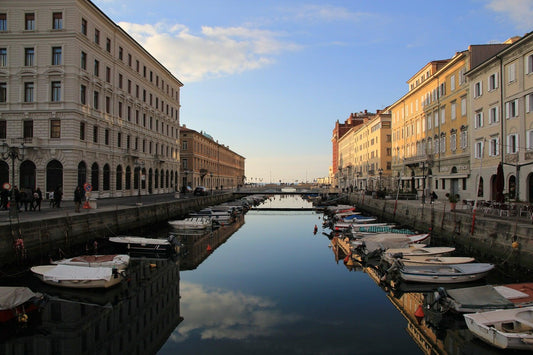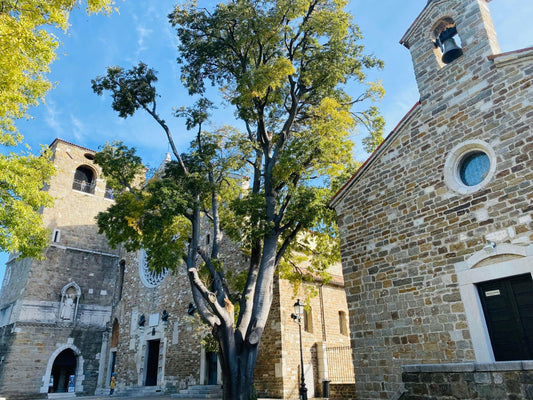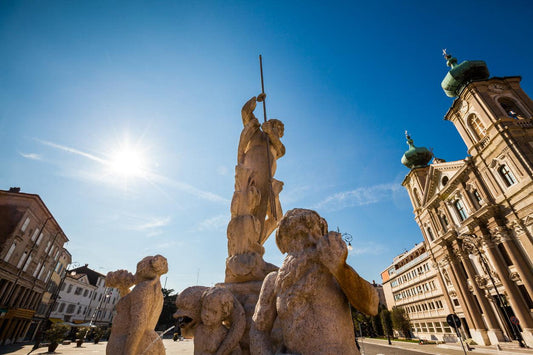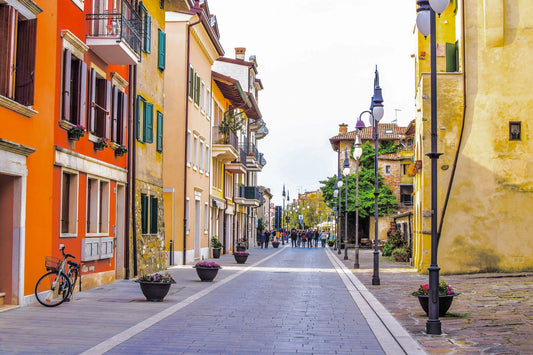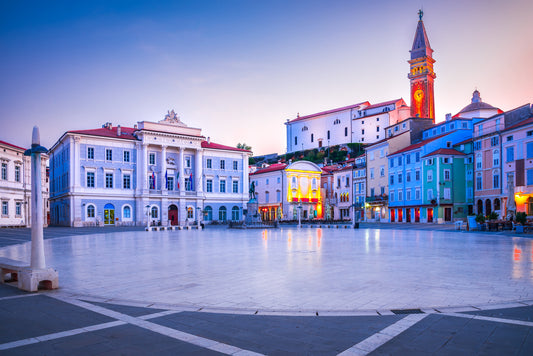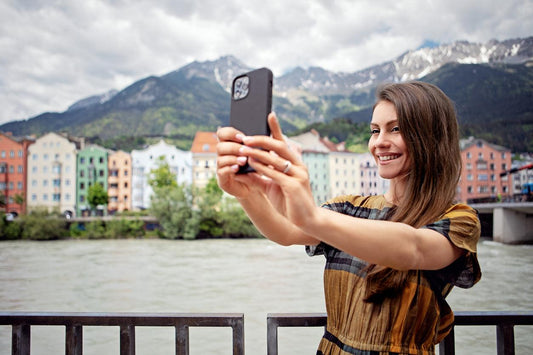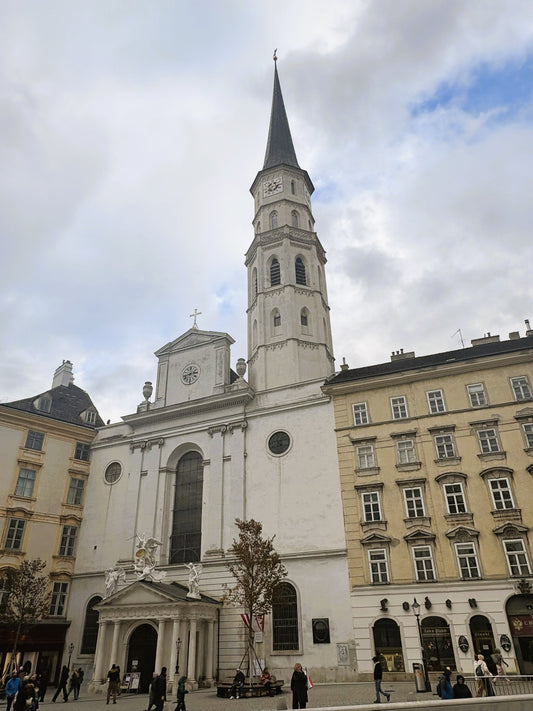
🏛️ Piran Sights – These Highlights You Can’t Miss
Share
Piran is Slovenia's coastal jewel, combining history, architecture, and Mediterranean charm. Whether for a day trip or a long weekend, the old town is compact, charming, and full of surprises. In this guide, we'll show you the most beautiful sights in Piran – including insider tips and a very special bonus: a self-guided city tour that lets you experience Piran in a flexible and fun way!
Welcome to Piran!
Piran has a charming old town and a fascinating, rich history! The picturesque architecture and culinary delights invite you to stroll, explore, discover, and chill! Dolce Vita in Slovenia 😉 By the way, the coffee here is almost as good as in Trieste 😉
ℹ️ You will learn this in this article:
- The history of Piran
- The most important sights in Piran
- The most beautiful activities in Piran
- The connection between Portorož and Piran
- Culinary highlights
- Discover Piran with the Feel-the-City scavenger hunt on a self-guided city tour
🏛️ The history of Piran
Piran 's history dates back to ancient times . Originally settled by Illyrians , the area came under Roman control in the 2nd century BC. During Roman times, Piran was a small coastal town in the Venetia et Histria region.
After the collapse of the Western Roman Empire, Piran came under Byzantine influence in the 6th century. Control changed hands several times in the following centuries until the Republic of Venice finally asserted itself in the 13th century. This Venetian rule lasted almost five centuries and shaped Piran culturally and architecturally to this day. You can clearly see this in the palazzi, loggias, and Venetian architectural style of the Old Town!
After the fall of Venice, Piran first fell to the Habsburg Empire (1797), then was briefly under Napoleonic administration before becoming part of the Habsburg littoral again in 1813. During the Austro-Hungarian Empire, Piran was a flourishing port and spa town with a lively exchange between Slovenian, Italian and Austrian culture.
After the First World War , Piran was awarded to the Kingdom of Italy in the 1920 Treaty of Rapallo – a period characterized by strong Italianization. Only after the Second World War , and after several political upheavals, did Piran become part of Yugoslav socialism in 1954 (more precisely, part of the Socialist Republic of Slovenia within Yugoslavia), which led to a large-scale emigration of the Italian-speaking population.
Since Slovenia's independence in 1991, Piran has been part of the Republic of Slovenia.
⭐ The most important sights in Piran

🟣 1. Tartini Square – The heart of the city
Piran's central square is the heart of the town. Named after the famous violinist Giuseppe Tartini , it stands on the site of the former harbor, which was filled in in the 19th century. Surrounded by elegant buildings such as the Town Hall, the Tartini House, and the Hotel Tartini, the square is an ideal place to relax and a starting point for sightseeing.
🟣 2. Tartini House (Tartinijeva hiša)
Giuseppe Tartini's birthplace is one of the oldest buildings on the square. Today, it houses a small museum dedicated to his life and work. Particularly worth seeing are Tartini's original violin and a collection of manuscripts.
🟣 3. St. George's Cathedral (Cerkev sv. Yurija)
The church sits perched on a hill above the old town and is dedicated to the patron saint of Piran. Its current Baroque appearance dates back to the 17th century. The forecourt offers one of the most beautiful views of the Adriatic. Particularly striking is the freestanding bell tower, modeled after the Campanile of St. Mark's in Venice.
🟣 4. Piran City Walls (Mestno obzidje)
The well-preserved medieval city wall, with its several towers, offers one of the best panoramic views of the old town, the sea, and the surrounding coast. The oldest part of the wall dates back to the 7th century, with later extensions following in the 15th century.
🟣 5. Venetian House (Benečanka)
Located directly on Tartini Square, this 15th-century Gothic house is one of the finest examples of Venetian architecture in Slovenia. The house is famous for its facade, which bears the phrase "Lassa pur dir" ("Let them talk") – supposedly a reference to a love affair between a Venetian woman and a Piran man.
🟣 6. The city wall with panoramic views
If you're looking for a spectacular photo of Piran, this is your spot . The historic city walls on the hillside offer one of the best views over the red roofs of the old town all the way to the Adriatic. It's most beautiful just before sunset—the entire city seems to glow golden. A true highlight among the sights in Piran!
🟣7. The Church of St. George – High above the sea
The Church of St. George stands proudly on the hill above Tartini Square. Its bell tower is reminiscent of the famous Campanile in Venice – and yes, you can climb it! In good weather, the view extends as far as Croatia and Italy. The interior is also worth a visit: frescoes, a wooden vaulted ceiling, and a spiritual tranquility await you.
🟣 7. Franciscan Monastery and Cloister (Samostan sv. Frančiška)
The tranquil monastery, with its beautiful Renaissance cloister, now houses a music institute and occasionally hosts concerts. Giuseppe Tartini is said to have once practiced his violin here. The acoustics in the courtyard are particularly beautiful.
🟣 8. Piran Aquarium
A small, family-friendly aquarium with marine animals from the Adriatic Sea, including starfish, octopuses, and seahorses. Ideal for bad weather or for families with children, it's located directly on the waterfront promenade.
🟣 9. The lighthouse at Cape Madona
At the very tip of the peninsula lies Cape Madona, with its small lighthouse. Here, city meets nature – sea meets history. The walk along the promenade there is romantic, tranquil, and perfect for unwinding. Less well-known, but all the more beautiful: a true insider tip for your Piran bucket list.
🟣 10. Sečovlje Saltworks Park (Krajinski park Sečoveljske soline)
Just outside, but easily accessible, are the historic Sečovlje salt pans, where sea salt has been extracted using traditional methods for over 700 years. The nature park is a UNESCO World Heritage candidate and a habitat for numerous bird species.
Extra tip: Discover Piran with our digital scavenger hunt
If you don't just want to see Piran, but really experience it , try our interactive city tour "Feel the City – Piran"!
You get:
✅ Exciting information about the places directly on your smartphone
✅ Puzzles & questions that you can only solve on site
✅ A flexible schedule – without any group or fixed times
🎯 Click here for the tour :
👉 Feel the City – discover Piran
🌊 The most beautiful activities in Piran: What you absolutely must experience
Whether culture, nature, or pleasure – Piran offers something for every taste. This charming coastal town invites you to relax, explore, and enjoy. Here are the best activities you shouldn't miss:
🏛️ 1. Stroll through the old town with the self-guided city tour
The car-free old town, with its winding alleys, Venetian buildings, and picturesque squares, is ideal for a stroll. Let yourself be carried away, discover hidden courtyards, colorful shutters, and small galleries.
🏖️ 2. Swimming and sunbathing on Piran's coast
Although Piran doesn't have any sandy beaches, the rocky coast and bathing platforms directly along the promenade invite you to sunbathe and swim. Particularly beautiful:
- Piran city beach (centrally located)
- Fiesa Beach (quiet bay)
- Natural beach in Strunjan (in a protected park)
📸 3. Enjoy the view from the city wall
A highlight for all those who enjoy photography: From the medieval city walls there is a spectacular panoramic view over the roofs of Piran, the Adriatic Sea and as far as Croatia and Italy.
Entrance fee: Small fee, but worth it at sunrise or sunset!
🎻 4. Walk in Tartini's footsteps
Visit the Tartini House, the birthplace of violinist Giuseppe Tartini. It contains original sheet music, a violin, and fascinating insights into the life of an 18th-century musical genius.
🧂 5. Excursion to the Sečovlje salt pans
Just a few kilometers away are the historic salt marshes – a UNESCO World Heritage candidate.
Experience the centuries-old salt production on a guided tour and discover rare bird species in the nature park.
🐠 6. Visit the Piran Aquarium
Perfect for families or when it rains: The small aquarium displays marine life from the Adriatic – from sea urchins to octopuses.
Tip: Ideal as a short detour directly on the waterfront promenade.
🚴 7. Discover the coast by bike
Piran lies on a beautiful section of the Parenzana cycle path – a former railway line that now serves as a cycle path connecting Slovenia, Italy and Croatia.
Bicycles can be rented in Piran.
🍷 8. Enjoy culinary delights and wine
Whether it's brodet, truffle pasta, or seafood – in Piran, only fresh produce is served. Add a glass of Malvazija or Refosco – and the sunset by the sea is perfect.
Tip: Visit one of the traditional konobas or wine cellars in the old town.
🏖️ Portorož – The elegant seaside resort near Piran
Portorož (Italian: Portorose , "Rose Harbor") is part of the municipality of Piran and is located about 3 km from the center of Piran . A walk or bike ride between the two towns will take you along the waterfront promenade – simply beautiful! Piran will enchant you with its historic old town, while Portorož will enchant you with its wellness, beach holidays, and sophisticated flair .
🕰️ History of Portorož
Portorož also has an interesting history: Its origins date back to the Middle Ages , when small settlements formed in the bay around the Benedictine Abbey of St. Lawrence. The name "Portorose" was first documented in the 13th century.
The true heyday, however, only began in the late 19th century , when Portorož became a popular spa resort of the Habsburg monarchy . The healing power of the salt brine and sea mud from the nearby Sečovlje salt pans attracted numerous spa guests from Vienna, Trieste, and throughout Central Europe.
At the turn of the century, Portorož was one of the region's most famous seaside resorts, comparable to Opatija or Abbazia. Luxury hotels like the still-operating Hotel Kempinski Palace recall this golden era.
🍽️ Culinary highlights in Piran
Piran's culinary heritage is strongly influenced by Mediterranean, Istrian, and Venetian cuisine . Its proximity to the sea, the Sečovlje salt pans, and the Istrian wine region make it a truly gourmet destination, especially if you like fish and wine.
🐟 Fresh fish & seafood
Piran's cuisine is inextricably linked to the sea. Restaurants serve freshly caught fish, mussels, calamari, and shrimp, usually grilled or tossed in olive oil, garlic, and white wine.
You should definitely try:
- Brodet : A typical Adriatic fish stew with tomatoes, garlic, and various types of fish. Traditionally served with polenta .
- Black Risotto : Colored with squid and its ink – a classic along the coast.
- Mussels "na buzaro" : sautéed in white wine, garlic, parsley and olive oil.
🧂 Salt from the Sečovlje salt pans
The hand-harvested Fleur de Sel (Piransko sol) from the nearby salt pans is a culinary landmark of the region. It's harvested using traditional methods without chemical additives and sold as high-quality table salt—including in local shops and delicatessens. We looooove this salt🤩
🍷 Local wines & olive oil
Did you know that Piran is located in the Slovenian wine region of Istria? You should definitely try:
- Malvazija (Malvasia) : A fresh, dry white wine with fine acidity – ideal with fish.
- Refošk (Refosco) : A strong, dark red wine with light tannins – goes well with meat and pasta.
- The region’s cold-pressed olive oil is also particularly aromatic.
🥣 Other specialties
- Truffle dishes : Istria is known for black and white truffles – they are often found on pasta, in omelets or as oil.
- Bobiči : A rustic bean stew with corn and vegetables – originates from the coastal region and is mainly served in traditional konobas.
- Palačinke : Thin pancakes with sweet or savory filling – a popular dessert in Slovenia.
🗺️ Why you should discover Piran with the Feel-the-City scavenger hunt
Our interactive self-guided city tour is the most entertaining way to explore Piran. Instead of a traditional walking tour, you'll be treated to an exciting adventure full of history, sights, local anecdotes, and clever puzzles, all crafted with love and passion.
You do n't need a group or a guide —all you need is your smartphone and an internet connection . Start whenever you want, at your own pace, without any stress.
The scavenger hunt begins at Tartini Square , the heart of Piran, and takes you to the most important highlights such as St. George's Cathedral , the historic city walls, and through the winding alleys of the old town . Along the way, lovingly designed tasks and challenging puzzles await, requiring close observation and creative thinking.
Get ready for a journey full of surprises, delights and history – and discover Piran in your own personal way.
👉 Start your scavenger hunt now and see Piran with new eyes!
⁉️FAQ – Everything you should know before your holiday in Piran
How long does it take to explore Piran?
The old town can easily be explored in half a day. If you also want to swim or enjoy the city walls, you should plan a full day.
Where is it good to park in Piran?
Piran itself is car-free. It's best to park in the "Fornace" garage and take the free shuttle to the center.
Is there a fee to visit the city wall?
Yes, the entrance fee is a few euros – but it’s definitely worth it!
When is the best time to travel to Piran?
Spring and fall offer pleasant temperatures and fewer tourists. Summer is, of course, popular—but also crowded.
Can I do the scavenger hunt with children?
Yes! The tour is ideal for families – children ages 8 and up will really enjoy solving the puzzles.



